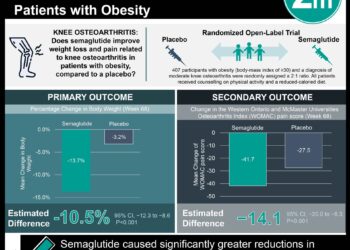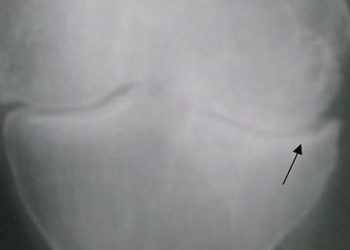Cardiovascular outcomes are similar for arthritis patients treated with selective and nonselective NSAIDs
1. Patients with arthritis treated with celecoxib experienced cardiovascular (CV) outcomes at a rate noninferior to those treated with ibuprofen or naproxen.
2. Celecoxib treated patients experienced adverse gastrointestinal events at a lower rate compared to patients treated with ibuprofen or naproxen.
Evidence Rating: 1 (Excellent)
Study Rundown: Nonsteroidal anti-inflammatory drugs (NSAIDs) are commonly used for pain management as they inhibit prostaglandin production. Selective NSAIDs are theorized to reduce gastrointestinal NSAID side effects while being similarly efficacious for pain control compared to nonselective NSAIDs. Previous research suggested selective NSAID use may result in more CV adverse events compared with nonselective NSAID use. This study aimed to assess CV and side effects seen when arthritis patients are treated with selective (celecoxib) or nonselective (ibuprofen or naproxen) NSAIDs and determine if the celecoxib regimen was noninferior to the ibuprofen or naproxen regimens.
A randomized controlled trial was conducted which included patients with arthritis that had CV disease or arthritis patients who were at increased risk of CV disease. Patients were treated with one of the three NSAIDs mentioned and followed to assess for potential side effects. CV side effect rates seen in patients treated with celecoxib were not worse than those of patients treated with ibuprofen or naproxen. Gastrointestinal side effects were observed significantly less in the celecoxib group.
Click to read the study, published today in NEJM
In-Depth [randomized controlled trial]: From 2006 to 2014, at 926 medical centers in 13 countries, 24 222 patients were enrolled in the study. Patients were assigned to celecoxib, naproxen, or ibuprofen groups in a randomized 1:1:1 fashion. Patients were eligible for the study if they required NSAID treatment for arthritis pain, and had either established CV disease or were at an increased risk for CV disease development. The celecoxib group had 8,072 patients (mean [±SD] daily dose, 209±37 mg), 7,969 patients in the naproxen group (852±103 mg), and 8,040 patients in the ibuprofen group (2045±246 mg). Mean treatment and follow-up duration for all patients was, respectively, 20.3±16.0 and 34.1±13.4 months.
The primary study outcome was death from any CV cause, secondary outcome was occurrence of a major CV event, and additional outcomes measured were gastrointestinal or renal adverse events. An intention-to-treat analysis revealed that the primary outcome occurred in 2.3% of the celecoxib group, 2.5% of the naproxen group, and 2.7% in the ibuprofen group. The HR for celecoxib compared to naproxen was 0.93 (95%CI 0.76-1.13; p < 0.001 for noninferiority). The HR for celecoxib compared to ibuprofen was 0.85 (95%CI 0.70-1.04; p < 0.001 for noninferiority). For secondary outcomes, the HR for celecoxib compared to naproxen was 0.97 (95%CI 0.83-1.12; p = 0.64), and the HR for celecoxib compared to ibuprofen was 0.87 (95%CI, 0.75-1.01; p = 0.06). Serious gastrointestinal events occurred significantly less in the celecoxib group comparted to the ibuprofen (HR 0.65; 95%CI 0.50-0.85; p = 0.002) and naproxen (HR 0.71; 95%CI 0.54-0.93; p = 0.01) groups. Significant renal events occurred significantly less in the celecoxib group compared to the ibuprofen group (HR 0.61; 95%CI 0.44-0.85; p = 0.004).
Image: CC/Wiki
©2016 2 Minute Medicine, Inc. All rights reserved. No works may be reproduced without expressed written consent from 2 Minute Medicine, Inc. Inquire about licensing here. No article should be construed as medical advice and is not intended as such by the authors or by 2 Minute Medicine, Inc.






